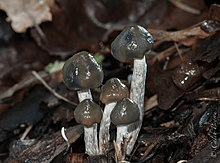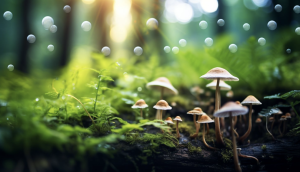The Safety Guide: How To Identify Psilocybin Mushrooms
- North Coast Remedies
- October 8, 2020
- News

“How To Identify Psilocybin Mushrooms that are Safe for Consumption”
A study of mushroom poisoning epidemiology in the US counts approximately thirty-nine people per year suffering from significant harm due to mushroom poisoning. The results come from approximating annual publications from the US National Poison Data System spanning the years 1999 to 2016. The researchers found out that the most common cause of these accidents is preventable MISIDENTIFICATION.
With the existence of over 10,000 known species of mushrooms and the unknown ones out there, it is easy to misidentify one and suffer mushroom poisoning. Many fungi are edible and farmed for the culinary world. These edible mushrooms have mainstream identification because chefs and cooks use them legally and openly. However, many users DIY and experiment for psilocybin mushrooms because there are only a few guides available due to its legal status as a Schedule I Drug alongside hard drugs like cocaine.
You must identify the right species to use if you’re looking forward to the spiritual high of magic shrooms. Right or wrong identification is the line between an out-of-body experience and a terrible body ache.
Poisonous Mushrooms
Mushroom poisoning causes gastrointestinal discomfort and, depending on how poisonous the mushroom is, can lead to death.
When looking for mushrooms, you must keep in mind a few defining traits that will help you avoid poisoning. Mushrooms that have white gills are often poisonous, and those with a ring around the stem and a volva are possibly harmful too. You have to dig around the mushroom base to find out if there’s a volva or not.
Beware. Some mushroom guides identify psilocybin mushrooms as poisonous or toxic, and one is the Amanita muscaria. This species is deadly in large doses, and guides use its characteristic red color to identify poisonous mushrooms. This inefficient cross-identification means that we still have a long way before we are entirely safe in exploring wild mushrooms; hence farming is the most reliable way of getting psilocybin.
What are Psilocybin Mushrooms?
Psilocybin mushrooms, also called shrooms or magic mushrooms, are hallucinogenic fungi. A shroom gives you a psychedelic high when you ingest a portion of it.
People high on mushrooms see patterns moving, smell words, and experience other mind-bending sensations and hallucinations like conversations with animals and inanimate objects.
While still categorized as a Schedule I drug, shrooms are now in legal studies for medicinal properties, especially in treating mental illnesses like major depressive disorder and treatment-resistant depression.
Studies have found that psilocybin rewires neurotransmitters in your brain so that your senses become mixed up, and once your high is over, your mind feels rebalanced – as it has gone through a reset.
The reset that psilocybin gives depression patients remove their feelings of fear and gives them weeks of pleasant state of mind.
Mushrooms have a strong potential in medicine and can become staple ingredients in producing legal drugs for depression, PTSD, Alzheimer’s, Parkinson’s, and other degenerative diseases. When this time comes, inevitably, there will be better identification for psilocybin mushrooms.
For now, articles like this one will take you a long way.
Avoid these Mushrooms
There are more poisonous mushrooms out there, but here are a few of the deadliest that you should avoid at all costs.
Here are five highly-poisonous mushrooms that can lead to grave illness and even death. Do not consume these deadly fungi – they will not give you a high. Mushroom poisoning from these species causes nausea, vomiting, flu-like symptoms, and damage to the liver and kidneys that may lead to an untimely death.
The Death Cap

Dapperling

The Dapperling is often mistaken for edible mushrooms. It is highly toxic and causes several deaths as it resembles the edible grey knight and fairy ring champignon mushrooms.
Skullcap

Destroying Angels

Webcaps

The Safest Psilocybin Mushrooms to Use
Here are a few of the most commonly used magic mushrooms that you can always depend on to be safe to use in the right doses.
Psilocybe semilanceata

These mushrooms can grow in meadows and pastures, often in sheep grazing areas. Unlike psilocybe cubensis, Liberty Caps do not grow directly out of dung.
Psilocybe mexicana

Psilocybe cyanescens

Psilocybe azurescens

It grows in the Oregon Coast and thrives in beach-land areas. It grows best in dune grasses, but it is a very adaptive mushroom that can survive harsh conditions.
Psilocybe baeocystis

Psilocybe cubensis

These shrooms grow throughout the southeastern United States, Central America, and North and South America. It also sprouts in Southeast Asia and other tropical regions in the world.
Mushroom Safety
While a mushroom guide can help you have your way with seasonal wild mushrooms, it is still safer to farm the mushrooms that you know you can use and will not kill you.
You can find online all the tools that you need to grow your psilocybin shrooms.

New Breakthrough-Neuroscirntists Discover How Magic Mushrooms Can "Rebalance" The Brain
Related Post
Explore Top Quality Shrooms Canada: Your Ultimate Guide to Buying Magic Mushrooms Online
- Posted January 13, 2024
- by North Coast Remedies
The Psilocybin Journey So Far
- Posted October 9, 2020
- by North Coast Remedies
New Breakthrough-Neuroscirntists Discover How Magic Mushrooms Can “Rebalance” The Brain
- Posted October 9, 2020
- by North Coast Remedies


